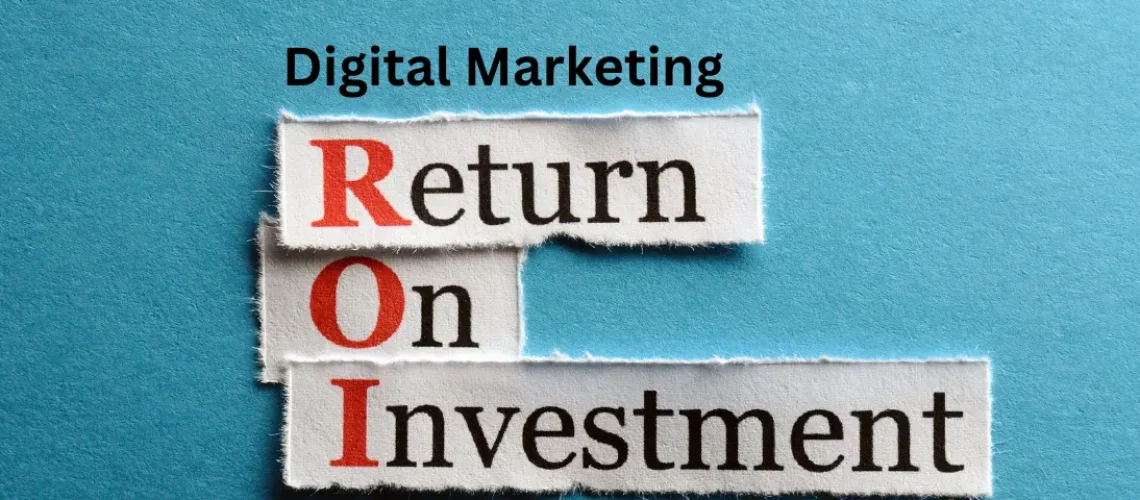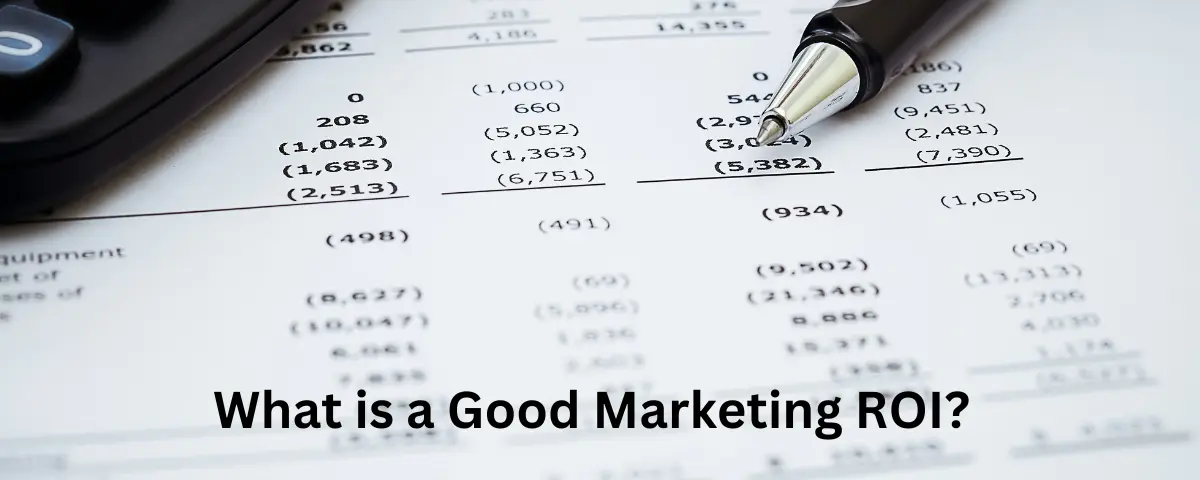In today’s rapidly evolving digital world, it is crucial for businesses to not only focus on digital marketing but also to monitor and assess the return on investment (ROI) of these efforts.
Many businesses invest in online ads, social media campaigns, and other digital strategies but struggle to measure their success. This is where ROI (Return on Investment) comes in.
Without a clear way to measure success, it’s easy to waste resources on campaigns that don’t bring real value. This can lead to frustration, missed opportunities, and poor business growth.
The good news is, that you can enrol for our digital marketing course and training to learn how to calculate ROI in digital marketing, so you can take control of your marketing strategy, focus on what works, and drive better results.
In this article, we will walk you through the steps to calculate ROI for your brand, so you can make better decisions and boost your marketing results.
What is Digital Marketing ROI?
Digital Marketing ROI (Return on Investment) is a metric that measures the profitability and effectiveness of your online marketing efforts. It compares the revenue generated from your digital marketing campaigns to the costs associated with running those campaigns.
Why Should Digital Marketers Care About ROI?
Digital marketers should care about ROI (Return on Investment) because it is a critical metric that helps evaluate the effectiveness of their marketing efforts.
1. Budget Allocation
Knowing your ROI helps in allocating your marketing budget effectively. If a particular channel or campaign is yielding high returns, it makes sense to invest more in it, while less effective channels can be adjusted or cut.
2. Performance Measurement
ROI provides a clear picture of how well your marketing efforts are performing. It helps identify which strategies are working and which ones need improvement.
3. Strategic Planning
Knowing your ROI helps with strategic planning by showing how your marketing efforts affect your finances. It allows you to make data-based decisions that match your business goals.
4. Demonstrating Value
For entrepreneurs and small business owners, demonstrating the value of marketing investments to stakeholders and investors is crucial. A positive ROI provides evidence of effective marketing strategies that work.
How to Calculate ROI for Digital Marketing
Get 50% Discount to Master ALL Aspects of Digital Marketing That Can Earn You $2,500 - $5,000 a month (Even if you are a complete beginner!)
Our students that intentionally implement what they learn from our digital marketing course make back the entire course fee within a single month or more after completing our course because our course gives them many income generating options with unlimited earning potential with no age or location barrier. The best part is no technical skills are required.
An opportunity to change your lifestyle and make money working from anywhere in the world. The results our students get from our digital marketing course prove this could be applied to any market or country and that it is designed for any skill level and work background.
*By signing up, you agree to our privacy policy and terms of service.
Return on Investment (ROI) in digital marketing measures the revenue generated from marketing activities in comparison to the costs involved. A favourable ROI signifies that the revenue surpasses the costs, whereas a negative ROI implies the contrary.
A simple formula to calculate Digital Marketing ROI is as follows:
ROI = (Revenue from Campaign- Cost of Campaign) / Cost of Campaign x 100
That is,
For example, if :
Revenue from Campaign = ₦100,000 (revenue generated)
Cost of Campaign – ₦50,000 (campaign expenses)
ROI: (₦100,000 – ₦50,000) / ₦50,000 x 100 = 100%
This means for every N1 spent, you gained N1 in profit.
This calculation will help you understand the profitability of your digital marketing efforts and determine the success of your campaigns.
As a business owner or digital marketer, it is important to understand that this simple formula does not consider all the complexities of digital marketing. In the current digital environment, calculating ROI has become more advanced and can take into account various factors, such as:
1. Multiple touchpoints: Digital marketing often requires interactions across various channels before a conversion takes place.
2. Long-term value: Some marketing strategies may not yield immediate results but can help build brand awareness and customer loyalty over time.
3. Customer Lifetime Value (CLV): CLV is the total value that a customer contributes to your business throughout the entire duration of their relationship, taking into account all purchases made, not just the initial one.
4. Attribution models: These are various models that can be utilized to attribute credit to different marketing touchpoints in the customer journey.
So to calculate digital marketing ROI accurately, it’s important to consider various activities to get a good result.
What is a Good Marketing ROI?
The return on investment (ROI) in marketing can differ based on the industry, business structure, and marketing tactics. Nonetheless, some standard benchmarks can assist in managing expectations.
1. 5:1 Ratio: It is widely recognized that a marketing ROI of 5:1 is considered favourable. This indicates that for every N1 invested in marketing, the business earns N5 in revenue. This is considered a solid performance in the majority of industries.
2. 10:1 Ratio: An outstanding marketing ROI is typically seen as 10:1, illustrating a very successful campaign where the returns greatly surpass the expenses. This suggests that N10 is gotten for every N1 spent.
2:1 Ratio: Conversely, an ROI of 2:1 is generally considered minimally profitable. This is because, after factoring in the costs of goods sold, the return is relatively low.
Ideally, a strong marketing ROI should exceed 100%, indicating that for every naira invested in marketing, the business or brand is generating more than a naira in revenue. This demonstrates that the marketing strategies are effective in boosting sales and aiding in the business’ overall development and prosperity.
How to Measure Digital Marketing ROI
Digital marketing has become an essential tool for businesses looking to reach their target audience in the online space. However, measuring digital marketing efforts’ return on investment (ROI) can be challenging.
To effectively measure digital marketing ROI, follow the steps below;
1. Establish a Realistic ROI Target
Determining a suitable ROI figure will vary depending on the specific objectives of your business. Generally, digital marketers view a 5:1 ratio as a favourable ROI, but this metric can differ based on the sector and particular campaign.
Various factors, including your target market, platforms, and content, can impact this figure. When you analyze your past performance and industry standards, you can select an appropriate ROI goal. The desired ROI may vary for each marketing initiative you undertake.
Whether it’s increasing website traffic, generating leads, or boosting sales, having specific goals in place will help you track the success of your digital marketing campaigns.
It is recommended to utilize the SMART method when establishing concrete, achievable goals. SMART stands for Specific, Measurable, Achievable, Relevant and Timely goals.
2. Select your Key Performance Indicators (KPIs)
Key Performance Indicators, or KPIs, are quantifiable metrics that demonstrate the effectiveness of achieving a business objective.
KPIs are essential for setting clear expectations for your campaigns and determining which metrics to monitor for return on investment (ROI). Choose between five and eight KPIs that are in line with your goals to gain a comprehensive understanding of your campaign’s scope.
These KPIs can include metrics such as website traffic, conversion rates, click-through rates, and customer acquisition costs. For example, if your goal is to increase sales, focus on conversion rates and revenue generated from specific campaigns.
Once you’ve determined your KPIs, consistently track and analyze them using analytics tools like Google Analytics or marketing software. These metrics will provide insights into what’s working and what needs improvement, allowing you to make data-driven decisions that enhance your digital marketing ROI.
3. Determine your Cost Per Lead
Determining your cost per lead can be helpful when aiming to grow your customer base. This metric shows you the average amount you are spending from your marketing budget to acquire each new lead.
To calculate the cost per lead, use this formula:
Cost per lead = Total Spent / Total Leads
For example, if you spent N5,000 on a campaign and generated 100 leads, your CPL would be N50. So when you understand your CPL, it will help you assess the efficiency of your marketing strategies and identify areas for improvement.
Also, by monitoring CPL across different channels such as social media, email marketing, and PPC, you can determine which methods yield the best results. This insight allows you to allocate your budget more effectively, focusing on the channels that deliver the highest-quality leads at the lowest cost, ultimately enhancing your overall ROI.
4. Monitor your Average Order Value
The average order value (AOV) is a metric that indicates the average amount of money a customer spends on a single order. Tracking this metric can be helpful if your objective is to monitor profit growth or customer retention.
Even minor improvements in AOV can result in higher revenue, leading to a positive impact on your return on investment (ROI). To calculate the AOV, use the following formula:
AOV = total revenue / total number of orders
Monitoring AOV helps you understand the effectiveness of your marketing strategies in driving higher-value transactions. If your AOV is low, consider implementing tactics to increase the average order size, such as offering product bundles, upselling complementary products, or providing discounts for larger purchases.
5. Monitor Conversion Rates
Monitoring conversion rates is a crucial step in measuring digital marketing ROI. The conversion rate indicates the percentage of visitors who complete a desired action, such as making a purchase, signing up for a newsletter, or filling out a contact form. To calculate your conversion rate, use this formula:
Conversions Rate = Total Conversions/Total Visitors ×100
For example, if your website had 1,000 visitors and 50 of them made a purchase, your conversion rate would be 5%.
So you should regularly track your conversion rates to help you assess the effectiveness of your marketing campaigns and identify areas for improvement.
6. Calculate your Click-Through Rate
The click-through rate (CTR) is a metric that indicates the number of individuals who visit your website or app by clicking a link you have shared elsewhere, such as in an email campaign or a linked advertisement on another platform. This metric provides insight into how many people are interacting with your external content to access your page.
To determine the CTR, use this formula:
CTR = (total number of clicks / total number of impressions) x 100
For instance, if your ad received 1,000 impressions and 50 people clicked on it, your CTR would be 5%.
Monitoring CTR helps you evaluate the effectiveness of your ad copy, images, and targeting strategies. A high CTR indicates that your ads are relevant and engaging to your target audience. So when you optimize your ads for higher CTRs, you can improve your ad rankings, reduce costs, and ultimately enhance your digital marketing ROI.
7. Monitor your Average Position
To understand how well your digital marketing efforts are performing in search engine results, you need to monitor your Average Position
Average Position refers to the average ranking of your ads or web pages for specific keywords. A higher position generally leads to more visibility and increased click-through rates.
To track your Average Position, use tools like Google Ads or Google Search Console. These tools will help you review your rankings for targeted keywords and identify trends over time. If your Average Position is declining, it may indicate that your SEO or ad strategies need adjustment.
8. Test, Monitor and make Adjustments where Necessary
Measuring your digital marketing ROI is an ongoing process that requires continuous testing, monitoring, and adjustments. You should analyze your key metrics, such as conversion rates, cost per lead, and average order value, to identify areas for improvement.
Also, conduct A/B tests to compare the performance of different ad copies, landing pages, or targeting strategies. Use the insights gained from these tests to optimize your campaigns and make data-driven decisions.
Finally, monitor your results closely and be prepared to make adjustments when necessary. If a particular channel or campaign is not delivering the desired ROI, consider reallocating your budget to more effective strategies.
How to Improve Digital Marketing ROI
Ensuring optimal ROI is a primary objective for businesses of all sizes when implementing digital marketing strategies. When you use the correct approach, you can be guaranteed that your marketing initiatives are not only effective but also cost-efficient.
1. Focus on High-Performing Channels
Identifying and prioritizing the channels that provide the best results is key to improving your digital marketing ROI. Start by analyzing your data to identify which marketing channels such as social media, email, SEO, or PPC for channels that generate the most conversions and revenue.
Once you’ve pinpointed these channels, allocate more of your budget and resources toward them. This might mean increasing ad spending on a successful PPC campaign or investing in content marketing that drives organic traffic. Additionally, continuously monitor the performance of these channels and make adjustments as needed.
2. Enhance Your Content Strategy
Content strategy is essential for increasing ROI. Start by understanding your target audience and creating content that addresses their needs, interests, and pain points. Businesses and brands that use blogging as a marketing strategy are 13 times more likely to see a positive return on investment.
To optimize the impact of your content:
- Produce high-quality, relevant content that addresses the needs of your audience
- Optimize your blog posts for search engines to boost organic traffic
- Implement persuasive calls-to-action (CTAs) to lead readers towards conversion
When you deliver high-quality, valuable content consistently, you can attract more leads, foster customer loyalty, and ultimately drive higher returns on your digital marketing investments.
3. Use Marketing Automation
Using marketing automation can significantly enhance your digital marketing ROI by streamlining your processes and improving efficiency. Marketing automation tools allow you to automate repetitive tasks such as email campaigns, social media posting, and lead nurturing. This not only saves time but also ensures that your marketing efforts are consistent and timely.
4. Continuous Testing
Testing and optimizing are crucial for enhancing your digital marketing ROI. To achieve this, it is necessary to take a data-driven approach. Consistently test various components of your campaigns, including:
- Ad copy and creatives
- Landing page layouts
- Email subject lines and content
- Call-to-action buttons
You should use A/B testing to pinpoint the most impactful variations of your campaigns and optimize them accordingly.
5. Invest in Remarketing
Remarketing allows you to reconnect with users who have previously interacted with your website or ads but did not convert. You can showcase displaying targeted ads to these potential customers as they browse other sites, to keep your brand top-of-mind and encourage them to return.
To implement a successful remarketing campaign, segment your audience based on their behaviour, such as pages visited or products viewed. Create tailored ads that address their specific interests or offer incentives, like discounts or free trials.
When you focus on users who are already familiar with your brand, you increase the likelihood of conversion, leading to a higher ROI.
Other Digital Marketing Metrics You Should Track
As stated earlier, although ROI is an essential metric for evaluating the effectiveness of your digital marketing strategies, it is also important to monitor other key metrics to fully understand the performance of your campaigns. Here are some important digital marketing metrics to keep track of:
1. Website Traffic
Website traffic measures the number of visitors to your site, providing insights into your marketing effectiveness. When you track your traffic sources, such as organic search, social media, and referrals. It will help you identify which channels drive the most visitors and optimize your strategies accordingly.
2. Conversion Rate
The conversion rate on your website is the percentage of visitors who complete a desired action, such as making a purchase or filling out a form. This metric helps you evaluate the effectiveness of your marketing campaigns and identify areas for improvement to boost overall performance.
3. Customer Lifetime Value (CLV)
Customer Lifetime Value (CLV) is a measure of the total revenue a business can expect from a single customer over their entire relationship. This metric helps you understand customer loyalty, optimize marketing budgets, and develop strategies to enhance retention and maximize profitability.
4. Social Media Engagement
As a digital marketer, one crucial metric that you should regularly monitor is social media engagement, which includes likes, shares, comments, and overall interaction with your content. Unlike traditional metrics like reach or impressions, engagement offers insight into how effectively your audience connects with your brand’s content, understands audience preferences, and refines your social media strategy to foster stronger connections with your audience.
5. Email Marketing Metrics
Email marketing is a vital digital marketing strategy that enables businesses to connect directly with their target audience. So for you to maximize the success of email campaigns, it is crucial to track specific metrics.
You can monitor metrics such as open rates, click-through rates, and conversion rates, to gather insights into the effectiveness of your campaigns. When you track these metrics, it helps you understand audience engagement, optimize your email content, and improve overall campaign performance for better ROI.
Examples of Marketing ROI
Now that you understand the importance and application of marketing ROI, let’s explore some scenarios to better explain this concept using real-world examples.
Email Marketing Campaign
Let’s take into account a digital marketer working for a retail client who launched a promotional email campaign to increase sales of a new product line. The marketer starts by monitoring important metrics such as the overall campaign costs and the total revenue generated from it.
For instance, the marketer invested N1,000,000 in an email campaign, covering expenses for design, content creation, and email distribution tools. She monitored sales directly linked to the campaign by analyzing the unique coupon code. Upon completion of the campaign, she determined that the total sales attributed to the email campaign were N5,000,000.
To calculate the ROI, the digital marketer applied the formula:
ROI = (Revenue – Cost) / Cost x 100
Using the figures, the ROI was calculated as ((N5,000,000 – N1,000,000) / N1,000,000)) x 100 = 400%
She would interpret the ROI of 400% to mean that the email marketing campaign was exceptionally successful. It not only yielded substantial profits but also offered valuable insights into customer preferences and behaviours.
The digital marketer can present these findings to the client, showcasing the effectiveness of email marketing in boosting sales. She can utilize the collected data to enhance future campaigns by refining targeting strategies and optimizing email content, ultimately ensuring even higher ROI.
Video Marketing Campaign
A small local bakery wants to increase its customer base and promote its new line of speciality cakes. To achieve this, the owner decided to create a series of five engaging promotional videos showcasing the cakes and including tracking links to a landing page where viewers can order online.
Campaign Details:
Cost of Video Production: The bakery spends N300,000 on creating the videos and N200,000 on promoting them through social media ads.
Results: After launching the video campaign, the bakery receives:
10 leads from viewers who clicked through to the landing page.
5 of those leads end up making a purchase.
The average sale per customer is N15,000.
Calculating Revenue:
To calculate the total revenue generated from the video marketing campaign, we multiply the number of customers who purchased by the average sale:
Total Revenue = Number of Purchases x Average Sale
Total Revenue = 5 x N15,000 = N75,000
Calculating ROI:
ROI = (Revenue – Cost) / Cost x 100
= 75,000 – 500,000/500,000 x 100
= -425,000/500,000 x 100
Ans = -85%
In this example, the bakery’s video marketing campaign resulted in a negative ROI of -85%, indicating that the campaign did not generate enough revenue to cover its costs.
Tools to Help Determine ROI in Digital Marketing

For a digital marketer or small business owner seeking to evaluate the impact of their digital marketing campaigns, there are various tools available to offer valuable insights on ROI.
Some of these tools are specifically designed to monitor performance, analyze user engagement, and offer valuable insights into the success of marketing campaigns.
The following are essential tools that can assist in monitoring performance and enhancing marketing strategies:
1. Google Analytics
Google Analytics is a widely used tool for calculating ROI. It is a free platform that provides extensive data on website traffic and user behaviour.
When you establish your goals and monitor conversions, you can evaluate the success of your marketing efforts. You can also determine the most effective channels for driving traffic, and pinpoint areas for enhancement.
With Google Analytics, you can:
- Establish objectives to monitor key actions such as form submissions, downloads, or purchases
- Assign conversions to particular marketing campaigns by utilizing UTM parameters
- Evaluate metrics such as bounce rate, time on site, and pages per session to measure engagement
Furthermore, Google Analytics can be integrated with other Google products to give a thorough understanding of how marketing strategies impact overall business performance.
2. Hubspot
HubSpot is another valuable tool that businesses can use for marketing automation. This platform offers robust analytics capabilities, allowing businesses to track leads, manage customer relationships, and analyze the performance of their marketing campaigns all in one place.
With detailed reporting features, businesses can easily evaluate their marketing spend about the revenue generated, determining the ROI for each campaign.
3. Social Media Analytics Tools
Social media analytics tools such as Facebook Ads Manager, Twitter Analytics, and LinkedIn Analytics offer valuable insights into the effectiveness of your social media marketing efforts.
These tools allow you to monitor engagement metrics such as likes, shares, and comments, as well as track click-through rates to your website. In addition, you can analyze cost per click and cost per lead for paid social ads to optimize your campaign performance.
4. Customer Relationship Management (CRM) Systems
Customer Relationship Management (CRM) systems are effective tools for monitoring sales and customer interactions. With CRMs, you can:
- Connect leads and revenue to specific marketing touchpoints
- Evaluate customer lifetime value (CLV)
- Determine metrics like customer acquisition cost (CAC)
One of the main benefits of using CRM systems to measure digital marketing ROI is their capability to monitor customer journeys across various channels. This monitoring enables businesses to identify which marketing efforts are resulting in conversions, whether through direct sales or lead generation.
Conclusion
ROI in digital marketing is an essential measure for businesses aiming to optimize the effectiveness of their digital marketing campaigns. It allows you to see what’s working, make informed decisions, and adjust your strategies to achieve better results.
Also, tracking your ROI regularly can help you make smarter decisions, avoid wasting money, and focus on strategies that grow your brand.
When you use this simple approach, it will help you get better results and ensure your marketing budget is spent wisely.
If you want to learn how to run marketing campaigns that get good results, you can check out our comprehensive digital marketing course to get started.
FAQ
What does ROI mean in marketing?
Return on Investment (ROI) in marketing is a metric used to evaluate the profitability of marketing campaigns in relation to the costs incurred. It calculates the amount of revenue generated for each dollar spent on marketing activities. ROI allows businesses to analyze the effectiveness of their marketing strategies by comparing the financial returns from campaigns with the expenses associated with implementing them.
What is ROI and KPI in digital marketing?
In the realm of digital marketing, ROI (Return on Investment) and KPI (Key Performance Indicator) are fundamental metrics utilized to assess the efficiency of marketing strategies.
ROI quantifies the profitability of a marketing campaign by comparing the revenue generated to the costs incurred. It enables businesses to comprehend the amount of return they are achieving for every dollar spent on marketing endeavors. A positive ROI indicates a successful campaign, while a negative ROI suggests the need for optimization.
Key Performance Indicators (KPIs) are specific metrics used to measure the performance of different marketing activities against predetermined objectives. Examples of KPIs include website traffic, conversion rates, customer acquisition cost, and social media engagement. These indicators offer valuable insights into the effectiveness of marketing strategies and assist in making informed decisions.
How is ROI calculated?
ROI in digital marketing is determined by dividing the net profit generated from a campaign by the total cost of the campaign. The resulting figure is then multiplied by 100 to obtain a percentage, which indicates the return on investment.
It is crucial to accurately calculate ROI by taking into account all expenses related to the campaign, such as advertising costs, agency fees, and other overheads. This enables businesses to effectively measure the success of their digital marketing efforts.
Further Reading
How To Use Influencer Marketing To Grow Your Small Business in 2024
15 E-commerce Marketing Strategies to Grow Your Business
Digital Marketing vs Traditional Marketing in 2024: Which is Better?







